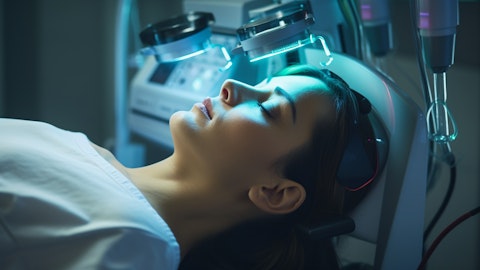Sandra Beaver: Hi, Marc, it’s Sandra here. Thanks so much for the question. As it relates to the overall market, I think one of the benefits of having more companies reporting, it gives us a little more clarity on sort of how to triangulate the full market, obviously, so one yet to go. But as indicated by our performance and what you’re hearing in the market, we still believe this is an underlying very healthy market. We can’t get to a precise number on market growth on any quarter, but certainly growing and growing at a healthy rate. which gives us that confidence that there’s a continued demand for the product in the market, and there continues to be overall health. In Europe, for us, as a newer entrant into many of these markets, our pacing is significantly above market in terms of growth.
It makes it a little harder for us to see when you’re new to a market, what the underlying market growth is, particularly as we are entering into new markets in Europe. We’re penetrating our share as we did here in the US much more deeply in those that we entered first, most notably the UK and we’re still earlier days and those like Italy that we enter into the back half of last year and growing at a rate that’s significantly higher than what we expect the market is growing. Hard for us to read through one other competitor that might be reporting as it relates to Europe.
David Moatazedi: And maybe the only other thing I’d add is the Europe launch we track each market very closely and look at analogs like the US and Canada. And we feel really confident about the uptake we’re getting out of these new markets we’re entering. But keep in mind, the pricing dynamics between Europe and the United States are pretty significant in terms of the difference. And so that’s what factors into the values of the respective markets.
Marc Goodman: You talked about the customer loyalty in the U.S., that $40 certificate. Is that the same thing that was going on last quarter as well?
David Moatazedi: Yes, that’s part of our Evolus Consumer Rewards program that we’ve launched several years ago, and we’ve continued to be consistent about our offer, which is $40 off for every consumer. So it’s been a multiyear effort. Mark, to that point, that consistency in offering $40 off for these consumers for multiple years is what’s really driving the increased traction you’re seeing in the market. That’s a meaningful savings for these consumers when you think about a $300 to $500 treatment for them when they can count on $40 on every visit.
Operator: Thank you. Our next question comes from the line of Navann Ty with BNP Paribas. Please proceed with your questions.
Navann Ty: Hi. Thanks a lot taking my question. A follow-up on US toxin competition, if I may. If you could discuss your assumptions for 2025 — 2024 and 2025 outlook in terms of price and differentiation for the new entrants? And then separately, if you could discuss the potential uses of proceeds of the opportunistic €50 million offering. Thank you.
David Moatazedi: Great. Thanks for the question, Navann. I’ll let Sandra take the last portion around the use of the proceeds. I’ll start with the marketplace. Look, I think we expected to see a new entrant coming in later this year. We’re very well aware of the product profile. I think at this point, rather than comment on any one competitor. I think we’ll address that as each new entrant comes in probably important to note that we expect this market to be healthy and growth. We have forecast this year that we’re going to gain share. That assumption assumes a new market entry. And when you look at our forecast of 2028, achieving $700 million, that also assumes several new market entrants. So I do think there’s an opportunity for new entrants to come in and carve out their own unique value proposition and for us to continue to do the same.
As it relates to how we consider each new entrant and what we may or may not do, I think those are the types of things that we’ll probably be sharing with you after the SaaS versus in advance.
Sandra Beaver: Hi, Navann, as it relates to your question on the proceeds from the raise, as we said before the raise and nothing has changed since we felt very confident we have sufficient cash and liquidity to carry ourselves through to profitability and beyond. The rate was specifically due to high inbound demand for our stock. We continue to see opportunity to shore up the balance sheet and give ourselves that incremental capacity in the event that there should be an opportunistic moment where we could invest. And a deal like you saw us do with, which is an incredibly capital-efficient deal to expand our portfolio with the cash we had on hand, we would have been limited in our ability to pursue those opportunities. And we now have a much healthier balance sheet position to be able to consider strategic opportunities.
Have said that there’s nothing imminent in front of us. There’s no reason why it was really an opportunistic moment in time when we could get new investors into the stock.
Navann Ty: Thank you.
Operator: Our next question comes from the line of Uy Ear with Mizuho Securities. Please proceed with your question.
Uy Ear: Hey, guys. Thanks for taking. So the first question is just digging a little deeper in terms of breadth and width of accounts. Maybe can you speak to the average do dollars per account and like what proportions may have a larger share of the dollars? That’s the first question. And the second question is, what should we expect to see at — when you present the data for the derma fillers? Just maybe some colors around expectations. Thanks.
David Moatazedi: Great. So let me just start with the market. Look, we don’t report out on the value per account. But I think just to dimensionalize it, right? There’s 30,000 customers in the U.S., you could simply a fly an 80-20 rule to sort of get a better understanding of the category. And from there, you see that there’s about 24,000 customers roughly, if you did an 80-20 rule, that represent the long tail. So certainly a lot more smaller value customers out there throughout the U.S. that are either newer to aesthetics or just dabbling in aesthetics and treating a smaller number of patients. And then the remaining 20% or call it, roughly 6,000 customers are the ones that are driving the large majority of the revenue. And clearly, our preference would be to try to take on the highest value customers.





